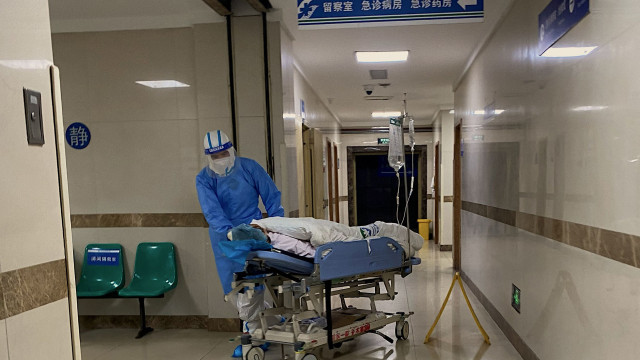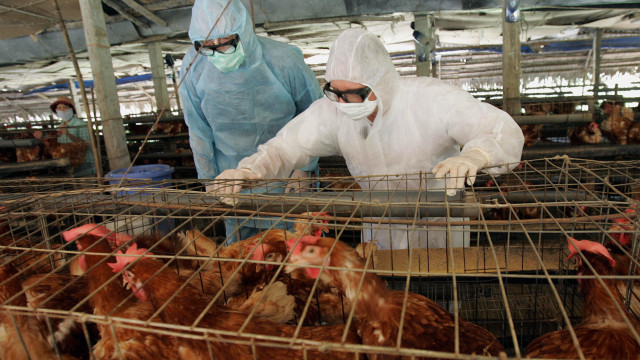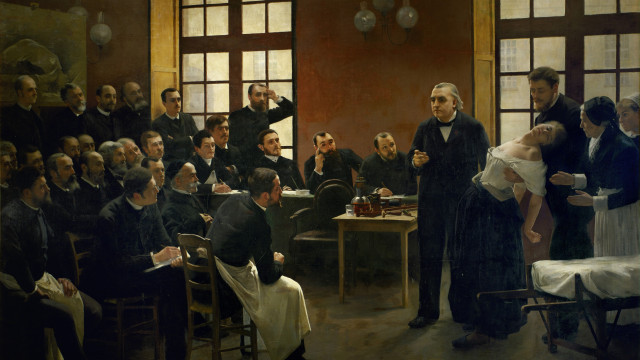





























See Also
See Again
© Getty Images
0 / 30 Fotos
Cancer: a system error?
- Before we try to unravel the mystery behind cancer and old age, let's understand the basics of how biological systems function and what happens when these systems develop errors.
© Getty Images
1 / 30 Fotos
Life as a function of biological systems
- Living organisms are a combination of complex systems that interact with their environment. These systems are fine-tuned to coexist harmoniously with their surrounding, deriving nourishment in the form of organic and inorganic substances for sustenance, growth, and survival.
© Getty Images
2 / 30 Fotos
The human body
- Like every other multicellular life form, the human body is also a combination of interdependent biological processes as complex as the engineering of a commercial jet, as organized as a car assembly line, and as precise and nuanced as a computer chip.
© Getty Images
3 / 30 Fotos
The human body
- But like all machines, there is considerable wear and tear. And over time, the biological processes that enable the body to survive, grow, and perform complex tasks throughout its lifetime begin to falter. And one such symptom of this system-wide deterioration is cancer.
© Getty Images
4 / 30 Fotos
The building blocks of life
- We have all heard that gene mutations are one of the primary causes of cancer. Genes are nothing but DNA sections that code for proteins that perform several vital functions in the body. DNA forms the fundamental unit of information present in every cell. We inherit this unit from our biological parents.
© Getty Images
5 / 30 Fotos
The building blocks of life
- Throughout our lifetime, we use this unit as a blueprint to create and regulate metabolic activities that are responsible for our survival, well-being, and, sometimes, illnesses and diseases.
© Getty Images
6 / 30 Fotos
The building blocks of life
- But how can the fundamental unit of life that is meant to be the engine of growth and sustenance lead to life-threatening and, sometimes, fatal diseases like cancer?
© Getty Images
7 / 30 Fotos
DNA damage
- There are several reasons for this. One of them is the continuous accumulation of DNA damage.
© Getty Images
8 / 30 Fotos
DNA damage
- Factors such as exposure to UV radiation, environmental toxins, inflammation, and bacterial and viral infections can all cause damage to our genetic blueprint.
© Getty Images
9 / 30 Fotos
DNA damage
- Various chemicals have been found to cause DNA damage. These include substances present in alcohol and cigarettes, as well as benzyl butyl phthalate (BBP), a compound commonly used in plastics. Food preservatives and additives, such as sodium benzoate and citric acid, may also have harmful effects. Additionally, synthetic food dyes like Red 40 and artificial sweeteners containing sucralose-6-acetate have been linked to DNA damage as well.
© Getty Images
10 / 30 Fotos
DNA repair
- To counter these effects, the DNA has high precision repair machinery consisting of different proteins and enzymes that efficiently repair mutation, breakage, abnormal structures, and lesions.
© Getty Images
11 / 30 Fotos
DNA repair
- But as we age, this machinery starts making errors. They may not make all the necessary corrections, may inaccurately repair the broken DNA pieces, or altogether fail to carry out their repair functions.
© Getty Images
12 / 30 Fotos
DNA damage accumulation
- As a result, these uncorrected mutations get copied at the time of cell division and keep getting accumulated. The more buildup of these mutations in the body, the greater the chances of unregulated cell division or cancer.
© Getty Images
13 / 30 Fotos
The body's defense
- Is there a way to prevent these mutations from multiplying, or defend the body against cells with accumulated mutations or on their way to becoming cancerous? This is where the immune system comes into action.
© Shutterstock
14 / 30 Fotos
The immune system
- The immune system generally protects the body from pathogens and is also effective in inhibiting the progression of cancerous cells.
© Getty Images
15 / 30 Fotos
The immune system
- The immune system of a young, healthy person is strong enough to identify, target, and neutralize cells that show signs of cancerous growth or proliferative activities.
© Getty Images
16 / 30 Fotos
The immune system
- But in the case of an aging body, the immune system loses its ability to protect the body against pathogens as well as its effectiveness against fighting cancer.
© Getty Images
17 / 30 Fotos
Proteins in defending the body
- Besides the immune system, certain proteins prevent tumor formation and cancer development. Once the proteins identify cancer-related abnormal cellular behavior, they alert other proteins through a molecular chain of commands to perform defensive actions.
© Getty Images
18 / 30 Fotos
Role of p53
- In particular, the protein named p53 plays a crucial role in preventing cells from becoming cancerous. This protein is highly sensitive to situations such as DNA damage, low oxygen levels, radiation exposure, and oncogene or cancer-causing gene activation.
© Getty Images
19 / 30 Fotos
Role of p53
- Upon detection of any of these conditions, p53 has the ability to initiate responses such as halting the progression of cell division. This prevents the mutated or damaged DNA from getting copied or replicated as it is and passed on to the new cell. If the DNA is damaged beyond the scope of repair, p53 can take the extreme step of activating cell death.
© Getty Images
20 / 30 Fotos
Role of p53
- After a certain age, p53 starts losing its efficiency in carrying out its functions. This means that, as we get older, DNA repair is not accurate, and mutations get multiplied and passed on to newer cells every time the cells divide. This eventually increases the chances of getting cancer.
© Getty Images
21 / 30 Fotos
Onset of cancer
- Now, let's look at some of the common cancer incidences and at what age do they occur.
© Getty Images
22 / 30 Fotos
Breast cancer
- Breast cancer is one of the most common cancers diagnosed in women over the age of 60. In fact, after the age of 65, the incidence (number of cases per 100,000 people) of breast cancer is 1.7 times higher than in women between the ages of 45 of 65, and 10 times higher than the incidence under the age of 45.
© Getty Images
23 / 30 Fotos
Prostate cancer
- In men, prostate cancer is most frequently diagnosed over the age of 65, and the incidence increases with advancing age. The incidence rate is about four times higher in the age range of 65 to 74, than in 45 to 64.
© Getty Images
24 / 30 Fotos
Lung cancer
- Both for men and women, lung cancer is among the most common type of cancer. In the US, it is the leading cause of cancer-related fatalities, responsible for one out of five deaths due to cancer. The incidence rate is between three to seven times higher in individuals between the ages of 60 to 79 compared to those aged 60 and lower.
© Getty Images
25 / 30 Fotos
Bladder cancer
- Bladder cancer occurrence is found in older individuals, with 90% of all cases being detected over the age of 55. There's a stark increase in the incidence rates, up to 20 times, in the age group of 50 to 64 in comparison to lower age groups.
© Shutterstock
26 / 30 Fotos
Pancreatic cancer
- Incidence rates of pancreatic cancer show a steady rise with age. The highest number of cases are found in adults aged 70 and above, with an incidence rate four to six times higher than those aged 55 or lower.
© Getty Images
27 / 30 Fotos
Targeting aging cells as a treatment
- Since aging cells play a major role in the onset of cancer, is there a treatment strategy to stop them from transforming into cancerous cells? Scientists who are working on this problem have already begun clinical trials to test the hypothesis of eliminating aging cells as a way to block the onset of cancer.
© Getty Images
28 / 30 Fotos
Targeting aging cells as a treatment
- The idea is that by using certain chemicals and drugs, scientists can selectively remove aging cells without harming the healthy ones. With this strategy in mind, clinical trials are being conducted on individuals using a combination of antioxidants called fisetin, polyphenol procyanidin C1 extracted from grape seed, and Dasatinib, a drug used in chronic myeloid leukemia. If these trials are successful, the strategy may have wider applications across age groups. Sources: (BBC) (Cancer Research UK) (Nature) (NIH) See also: A groundbreaking discovery in cancer drug development
© Getty Images
29 / 30 Fotos
© Getty Images
0 / 30 Fotos
Cancer: a system error?
- Before we try to unravel the mystery behind cancer and old age, let's understand the basics of how biological systems function and what happens when these systems develop errors.
© Getty Images
1 / 30 Fotos
Life as a function of biological systems
- Living organisms are a combination of complex systems that interact with their environment. These systems are fine-tuned to coexist harmoniously with their surrounding, deriving nourishment in the form of organic and inorganic substances for sustenance, growth, and survival.
© Getty Images
2 / 30 Fotos
The human body
- Like every other multicellular life form, the human body is also a combination of interdependent biological processes as complex as the engineering of a commercial jet, as organized as a car assembly line, and as precise and nuanced as a computer chip.
© Getty Images
3 / 30 Fotos
The human body
- But like all machines, there is considerable wear and tear. And over time, the biological processes that enable the body to survive, grow, and perform complex tasks throughout its lifetime begin to falter. And one such symptom of this system-wide deterioration is cancer.
© Getty Images
4 / 30 Fotos
The building blocks of life
- We have all heard that gene mutations are one of the primary causes of cancer. Genes are nothing but DNA sections that code for proteins that perform several vital functions in the body. DNA forms the fundamental unit of information present in every cell. We inherit this unit from our biological parents.
© Getty Images
5 / 30 Fotos
The building blocks of life
- Throughout our lifetime, we use this unit as a blueprint to create and regulate metabolic activities that are responsible for our survival, well-being, and, sometimes, illnesses and diseases.
© Getty Images
6 / 30 Fotos
The building blocks of life
- But how can the fundamental unit of life that is meant to be the engine of growth and sustenance lead to life-threatening and, sometimes, fatal diseases like cancer?
© Getty Images
7 / 30 Fotos
DNA damage
- There are several reasons for this. One of them is the continuous accumulation of DNA damage.
© Getty Images
8 / 30 Fotos
DNA damage
- Factors such as exposure to UV radiation, environmental toxins, inflammation, and bacterial and viral infections can all cause damage to our genetic blueprint.
© Getty Images
9 / 30 Fotos
DNA damage
- Various chemicals have been found to cause DNA damage. These include substances present in alcohol and cigarettes, as well as benzyl butyl phthalate (BBP), a compound commonly used in plastics. Food preservatives and additives, such as sodium benzoate and citric acid, may also have harmful effects. Additionally, synthetic food dyes like Red 40 and artificial sweeteners containing sucralose-6-acetate have been linked to DNA damage as well.
© Getty Images
10 / 30 Fotos
DNA repair
- To counter these effects, the DNA has high precision repair machinery consisting of different proteins and enzymes that efficiently repair mutation, breakage, abnormal structures, and lesions.
© Getty Images
11 / 30 Fotos
DNA repair
- But as we age, this machinery starts making errors. They may not make all the necessary corrections, may inaccurately repair the broken DNA pieces, or altogether fail to carry out their repair functions.
© Getty Images
12 / 30 Fotos
DNA damage accumulation
- As a result, these uncorrected mutations get copied at the time of cell division and keep getting accumulated. The more buildup of these mutations in the body, the greater the chances of unregulated cell division or cancer.
© Getty Images
13 / 30 Fotos
The body's defense
- Is there a way to prevent these mutations from multiplying, or defend the body against cells with accumulated mutations or on their way to becoming cancerous? This is where the immune system comes into action.
© Shutterstock
14 / 30 Fotos
The immune system
- The immune system generally protects the body from pathogens and is also effective in inhibiting the progression of cancerous cells.
© Getty Images
15 / 30 Fotos
The immune system
- The immune system of a young, healthy person is strong enough to identify, target, and neutralize cells that show signs of cancerous growth or proliferative activities.
© Getty Images
16 / 30 Fotos
The immune system
- But in the case of an aging body, the immune system loses its ability to protect the body against pathogens as well as its effectiveness against fighting cancer.
© Getty Images
17 / 30 Fotos
Proteins in defending the body
- Besides the immune system, certain proteins prevent tumor formation and cancer development. Once the proteins identify cancer-related abnormal cellular behavior, they alert other proteins through a molecular chain of commands to perform defensive actions.
© Getty Images
18 / 30 Fotos
Role of p53
- In particular, the protein named p53 plays a crucial role in preventing cells from becoming cancerous. This protein is highly sensitive to situations such as DNA damage, low oxygen levels, radiation exposure, and oncogene or cancer-causing gene activation.
© Getty Images
19 / 30 Fotos
Role of p53
- Upon detection of any of these conditions, p53 has the ability to initiate responses such as halting the progression of cell division. This prevents the mutated or damaged DNA from getting copied or replicated as it is and passed on to the new cell. If the DNA is damaged beyond the scope of repair, p53 can take the extreme step of activating cell death.
© Getty Images
20 / 30 Fotos
Role of p53
- After a certain age, p53 starts losing its efficiency in carrying out its functions. This means that, as we get older, DNA repair is not accurate, and mutations get multiplied and passed on to newer cells every time the cells divide. This eventually increases the chances of getting cancer.
© Getty Images
21 / 30 Fotos
Onset of cancer
- Now, let's look at some of the common cancer incidences and at what age do they occur.
© Getty Images
22 / 30 Fotos
Breast cancer
- Breast cancer is one of the most common cancers diagnosed in women over the age of 60. In fact, after the age of 65, the incidence (number of cases per 100,000 people) of breast cancer is 1.7 times higher than in women between the ages of 45 of 65, and 10 times higher than the incidence under the age of 45.
© Getty Images
23 / 30 Fotos
Prostate cancer
- In men, prostate cancer is most frequently diagnosed over the age of 65, and the incidence increases with advancing age. The incidence rate is about four times higher in the age range of 65 to 74, than in 45 to 64.
© Getty Images
24 / 30 Fotos
Lung cancer
- Both for men and women, lung cancer is among the most common type of cancer. In the US, it is the leading cause of cancer-related fatalities, responsible for one out of five deaths due to cancer. The incidence rate is between three to seven times higher in individuals between the ages of 60 to 79 compared to those aged 60 and lower.
© Getty Images
25 / 30 Fotos
Bladder cancer
- Bladder cancer occurrence is found in older individuals, with 90% of all cases being detected over the age of 55. There's a stark increase in the incidence rates, up to 20 times, in the age group of 50 to 64 in comparison to lower age groups.
© Shutterstock
26 / 30 Fotos
Pancreatic cancer
- Incidence rates of pancreatic cancer show a steady rise with age. The highest number of cases are found in adults aged 70 and above, with an incidence rate four to six times higher than those aged 55 or lower.
© Getty Images
27 / 30 Fotos
Targeting aging cells as a treatment
- Since aging cells play a major role in the onset of cancer, is there a treatment strategy to stop them from transforming into cancerous cells? Scientists who are working on this problem have already begun clinical trials to test the hypothesis of eliminating aging cells as a way to block the onset of cancer.
© Getty Images
28 / 30 Fotos
Targeting aging cells as a treatment
- The idea is that by using certain chemicals and drugs, scientists can selectively remove aging cells without harming the healthy ones. With this strategy in mind, clinical trials are being conducted on individuals using a combination of antioxidants called fisetin, polyphenol procyanidin C1 extracted from grape seed, and Dasatinib, a drug used in chronic myeloid leukemia. If these trials are successful, the strategy may have wider applications across age groups. Sources: (BBC) (Cancer Research UK) (Nature) (NIH) See also: A groundbreaking discovery in cancer drug development
© Getty Images
29 / 30 Fotos
Why cancer risk increases with old age
Are older people more prone to the disease?
© Getty Images
More than half of cancer cases reported in the UK occur in individuals over the age of 70, while in the US the average age at which cancer is diagnosed is 66. This suggests that aging is one of the primary factors responsible for cancer development. An important scientific hypothesis is that as people grow older their once healthy cells gradually begin to malfunction.
Over time, the body’s natural mechanisms for repairing and regulating cell growth become less efficient, allowing genetic mutations to accumulate. Ongoing research is shedding more light on specific mechanisms that lead to the onset of cancer in old age and developing targeted therapies to reduce these risks.
In this gallery, we look at the relationship between aging and cancer. Click on to learn more.
RECOMMENDED FOR YOU






























MOST READ
- Last Hour
- Last Day
- Last Week








